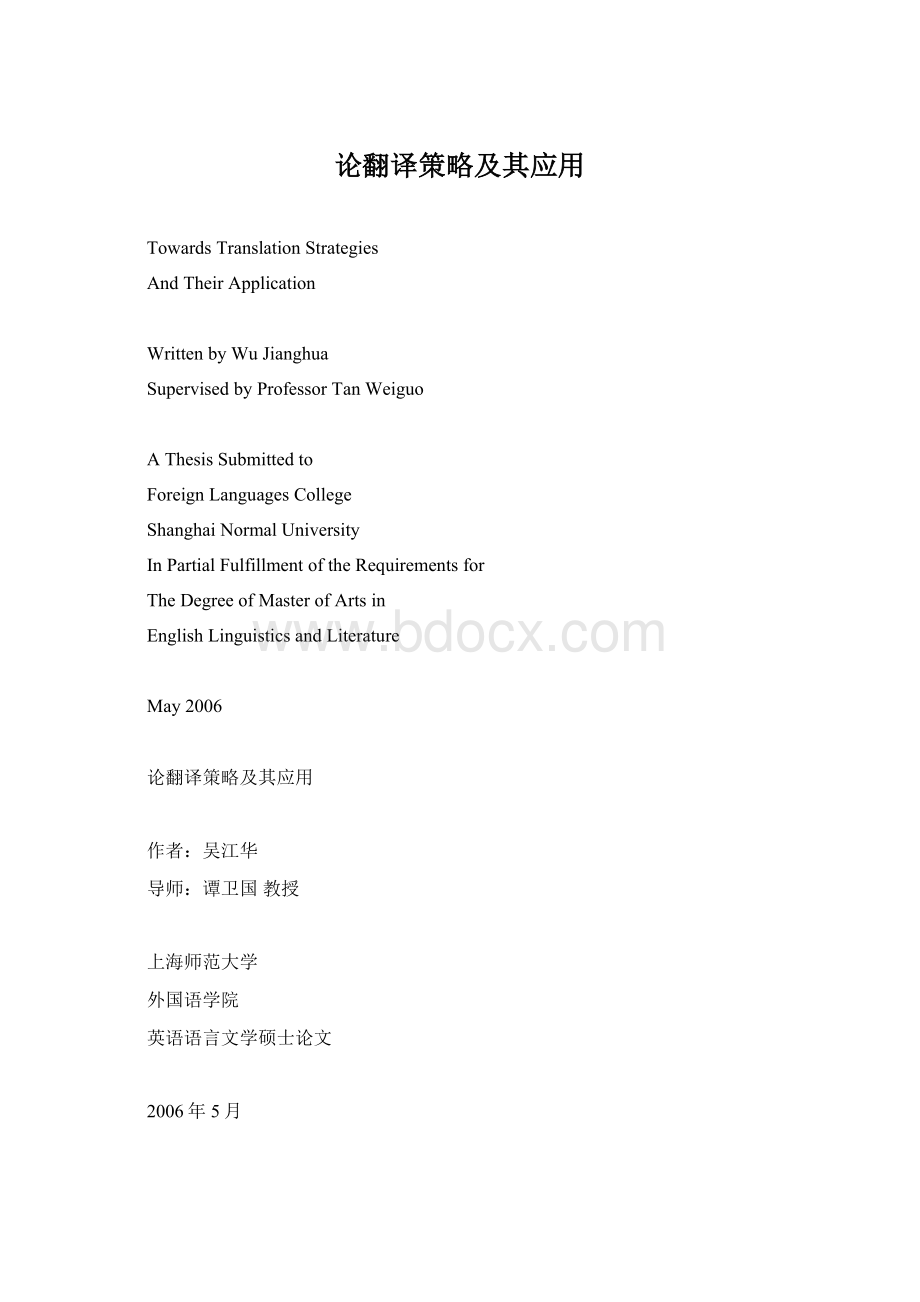论翻译策略及其应用.docx
《论翻译策略及其应用.docx》由会员分享,可在线阅读,更多相关《论翻译策略及其应用.docx(47页珍藏版)》请在冰豆网上搜索。

论翻译策略及其应用
TowardsTranslationStrategies
AndTheirApplication
WrittenbyWuJianghua
SupervisedbyProfessorTanWeiguo
AThesisSubmittedto
ForeignLanguagesCollege
ShanghaiNormalUniversity
InPartialFulfillmentoftheRequirementsfor
TheDegreeofMasterofArtsin
EnglishLinguisticsandLiterature
May2006
论翻译策略及其应用
作者:
吴江华
导师:
谭卫国教授
上海师范大学
外国语学院
英语语言文学硕士论文
2006年5月
Acknowledgements
Mymostsinceregratitudeshouldfirstgotomysupervisor,Prof.TanWeiguo,whoseconstantencouragement,illuminatinginstructionandmeticulousguidancehavegreatlycontributedtotheshapingofthisthesis.Itishewhohasguidedmeintotheacademicfieldoftranslationanditisalsohewhohasinspiredinmeaparticularinterestintranslationstrategies.Hecarefullyreadthevariousdraftsofmythesisandprovidedmewithinvaluablecommentsandsuggestions.Withouthiskindhelpandcarefuleffort,thisthesiswouldnotbewhatitappearsnow.
IamalsogreatlyindebtedtoProf.CaiLongquan,fromwhosecommentsandsuggestionsIhaveundoubtedlybenefitedagreatdeal.Besides,IwouldliketoextendmyappreciationtoProf.ChengXinghua,Prof.SuChengzhi,Prof.Zhouzhongjie,andProf.DengMingde,whohavealsohelpedmeinonewayoranother.ItwasthroughtheirlecturesIhadthechancestoacquaintmyselfwithknowledgeessentialforthisthesisandthatIbroadenedmyhorizonsinthefieldoftranslationstudies,linguisticsandliterature.Inaddition,mythanksalsogotoalltheotherteachersandmydearfriendsfortheirsupportandencouragementduringmythree-yearstudyasapostgraduate.
Finally,Idedicatethisthesiswithloveandgratitudetomyfamilymembers,whoarealwaystheretogivemeconstantencouragementandsupportwheneverIneed.Theirloveismyperpetualtreasure.
Abstract
Translation,whichactsasabridgebetweendifferentlanguagesandcultures,contributessignificantlytocross-culturalcommunication.Duringtheprocessoftranslation,translatorsalwayshavetomakeachoiceofwhichtranslationstrategyshouldbeadoptedtodealwiththedifferencesbetweentheSL-cultureandtheTL-culture.Domesticationandforeignizationaretwomajortranslationstrategies.Thisthesismakesanattempttodiscussthetwostrategiesandtheirapplicationfromtheperspectivesoftranslatology,linguisticsandinterculturalcommunication.
Thisthesisfirstsurveysthestatusquoofresearchesconcerningdomesticationandforeignizationathomeandabroadbeforeitpointsoutthenecessityofmakingfurtherstudiesofthesetwomajortranslationstrategies.Next,thethesisexpoundstherelationshipbetweenlanguageandcultureandthatbetweencultureandtranslation.Then,itdiscussesatlengththetwotranslationstrategies,includingtheirdefinitions,acomparativestudy,disputesinhistory,currentstudies,andtheauthor’sopinions.Thethesiscontinuestodealwithsuchneglectedfactorsasmayinfluencethetranslator’schoiceoftranslationstrategies:
thetypeofthesourcetext(ST),thetranslationpurposes,theleveloftheintendedreaders,thesocialandhistoricalbackground,thetranslator’sattitudeandsoon.Finally,fromthelinguisticandculturalperspectives,thethesismakesacomparativestudyoftheapplicationofdomesticationandforeignizationbyanalyzingtypicalexamplesfromthetwoEnglishversionsofHongLouMengtranslatedbyYangXianyiandDavidHawkesrespectively.
Thethesisconcludesthatthesetwotranslationstrategieshavetheirrespectivefeaturesandapplicablevalue.ItissincerelyhopedthatthisresearchintotranslationstrategieswillenlightentranslatorsandmakealittlecontributiontotheprosperityoftranslationstudiesandtranslationpracticeinChina.
Keywords:
translationstrategy;domestication;foreignization;application
摘要
翻译作为沟通不同语言与文化的桥梁,在跨文化交际中起着不可或缺的作用。
译者在翻译的过程中总会面临翻译策略的选择。
翻译策略是指译者在处理源语与译语语言文化差异时所用的方法。
在翻译中有两种基本策略:
归化和异化。
本文主要从翻译学、语言学和跨文化交际的角度来讨论这两种翻译策略以及他们的应用。
首先,文章概述了国内外翻译界对归化与异化研究的现状并指出继续深入研究的必要性;接着论述了语言、文化与翻译之间的相互关系;然后系统地讨论归化和异化这两种翻译策略,包括他们的定义,历史上的有关争论和当前的研究现状,并阐述了作者的观点。
接下来本文讨论了影响译者选择翻译策略的因素,例如:
文本类型、目标语读者的水平、翻译的社会历史背景、译者的翻译的目的及其文化态度等等。
作者试图通过对这些因素进行详细分析,并结合具体例子,分别从语言和文化层面对中国古典名著《红楼梦》的两个英译本中归化与异化的应用进行比较研究(杨宪益译本和霍克斯译本),来论证异化与归化看似矛盾,实则相互补充的辩证关系;异化和归化因其各具特点,在不同情况下都有其存在的价值,过于强调其中的一种是片面的,不科学的;译者应该根据文本类型、翻译目的和读者水平等因素来选择合适的翻译策略,绝对归化和绝对异化都是行不通的。
希望本文对翻译策略的研究能够给译者以启发,并达到进一步加强和丰富翻译理论、指导翻译实践的目的。
关键词:
翻译策略;归化;异化;应用
TableofContents
AcknowledgementsI
AbstractII
摘要III
TableofContentsIV
Chapter1Introduction1
1.1TheCulturalTurnintheStudyofTranslation1
1.2StatusQuoofStudiesofDomesticationandForeignization3
1.3ThePurpose,SignificanceandtheFrameworkoftheThesis4
Chapter2Language,CultureandTranslation6
2.1TheRelationshipBetweenLanguageandCulture6
2.2TheRelationshipBetweenCultureandTranslation7
2.3Translatabilityand“Untranslatability”ofCulture8
Chapter3TowardsDomesticationandForeignization11
3.1DefinitionsofDomesticationandForeignization11
3.2DomesticationandForeignizationVsFreeTranslationandLiteralTranslation13
3.3TheDisputesoverDomesticationandForeignizationinHistory15
3.3.1TheDisputesinChina15
3.3.2TheDisputesAbroad19
3.4CurrentStudiesofDomesticationandForeignization21
3.5TheAuthor’sUnderstandingofDomesticationandForeignization24
3.5.1WhyHavetheDisputesAlwaysBeenGoingon?
24
3.5.2AdvantagesandDisadvantagesofDomesticationandForeignization25
Chapter4FactorsInfluencingTranslator’sselectionofTranslationStrategies27
4.1TypesofText28
4.2SocialandCulturalBackground32
4.2.1SocialBackground32
4.2.2CulturalBackground34
4.3TargetLanguageReaders36
4.4TheSubjectiveFactorsInfluencingTranslationStrategies38
4.4.1PurposeofTranslator38
4.4.2Translator’sAttitude39
Chapter5TheApplicationoftheTwoStrategiestotheTwoEnglishVersionsofHongLouMeng41
5.1AGlimpseofHongLouMengandItsEnglishVersions41
5.2TheReasonsforChoosingTheseTwoEnglishVersionsofHongLouMeng42
5.3AComparativeStudyoftheTwoVersionsofHongLouMeng43
5.3.1LinguisticLevel43
5.3.1.1Vocabulary43
5.3.1.2GrammaticalStructure47
5.3.2CulturalLevel49
5.3.2.1EcologicalCulture49
5.3.2.2MaterialCulture51
5.3.2.3SocialCulture52
5.3.2.4ReligiousCulture55
5.3.2.5LanguageCulture57
5.4Summary59
Chapter6Conclusion60
Bibliography62
Chapter1Introduction
Nowadays,withtherapiddevelopmentofscienceandtechnologyandtheincreasinginterconnectednessoftheinternationaleconomicandculturalsystems,theworldisgettingsmallerandsmallerandbecomingaglobalvillage.Communicationamongthepeopleintheglobalvillageisgrowingmoreandmorefrequent.Translation,asameansoftransferringlanguagesaswellascultures,isplayinganincreasinglyimportantroleintheglobalization,whichalsogivesagreatimpetustothedevelopmentofcivilization.
1.1TheCulturalTurnintheStudyofTranslation
Forcenturies,thestudiesoftranslationhavebeensubsumedundereitheroftwodifferentsubjectsordisciplines:
linguisticsandcomparativeliterature.Traditionaltranslationstudiesmainlyinvolvethecomprehensionandcriticismoftheoriginaltextanditstranslation.Mostpapersontranslationfocusonlinguisticanalysisandtextualcomparison.Translationevenhasbeenseenasasegmentorsub-fieldoflinguisticsonthebasicpremisethattranslationisakindofcommunicationbetweentwolanguages,andtheobjectoftranslationstudyistoachieveakindofgrammaticalorsyntacticalequivalence.Before1970s,thestudyoftranslationoccupiedaminorcornerofappliedlinguistics,anevenmoreminorcornerofliterarystudies,andlittlepositionatallintheculturalstudies.
Butshortlyafterwards,itbegantobenoticedthattranslationisnotmerely“thereplacementoftextualmaterialinonelanguage(sourcelanguage)byequivalentmaterialinanotherlanguage(targetlanguage)”(J.C.Catford,1965:
20).HansVermeer,aGermantranslator,onceproposedhisunderstandingoftranslationfromaculturalperspectiveas“informationofferedinalanguagezofcultureZwhichimitatesinformationofferedinlanguageaofcultureAsoastofulfillthedesiredfunction.Thatmeansthatatranslationisnotthetranscodingofwordsorsentencesfromonelanguageintoanother,butacomplexactioninwhichsomeoneprovidesinformationaboutatextundernewfunctional,culturalandlinguisticconditionsandinanewsituation,wherebyformalcharacteristicsareimitatedasfaraspossible”(HansVermeer,1986:
36).
Inabroadsense,allhumanactivitiesareculturalactivities.Translationisnoexception.ChristianeNordusesthenotionof“interculturalcommunication”insteadof“translation”;Holz-Manttariuses“interculturalcooperation”torefertotranslation;R.DanielShawcoinstheword“transculturation”toreplacetranslation;AndreLefevereviewstranslationasakindof“acculturation”(Guo,1998:
12).Furthermore,LanceHewsonandJackyMartin(1991:
131-135),whileconsideringthetranslatoras“culturaloperator”,claimthat“culturalequationshouldbeanessentialpartoftranslationtheoryandpracticealike.”
In1990,SusanBassnettandAndreLefeverewerethefirsttosuggestthattranslationstudiestakethe“Culturalturn”,whichmarksashiftofemphasisintranslationstudiesfromthelinguisticanalysistothebroaderissuesofcontext,historyandconventionintheirco-editedworksofTranslation/History/Culture:
ASourcebook:
Onceuponatime,thequestionsthatwerealwaysbeingaskedwere“Howcantranslationbetaught?
”and“Howcantranslationbestudied?
”Thosewhoregardedthemselv